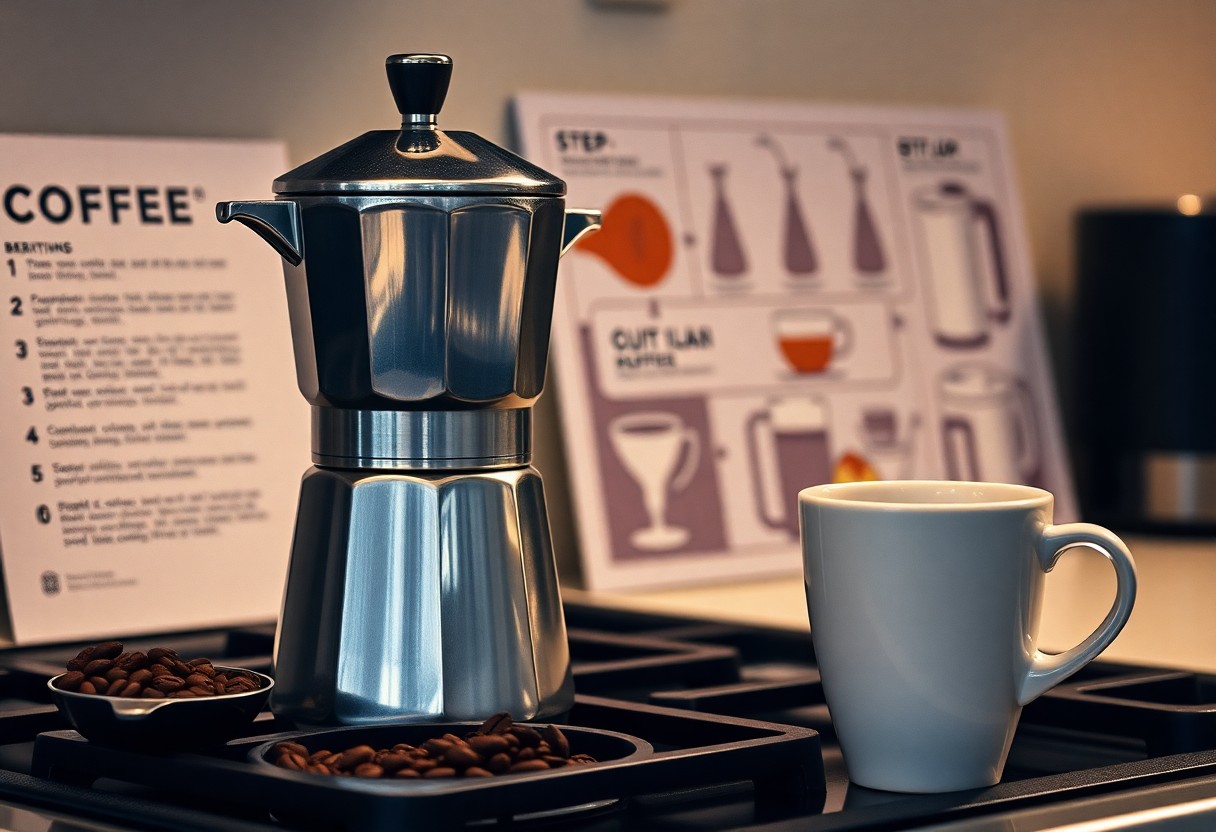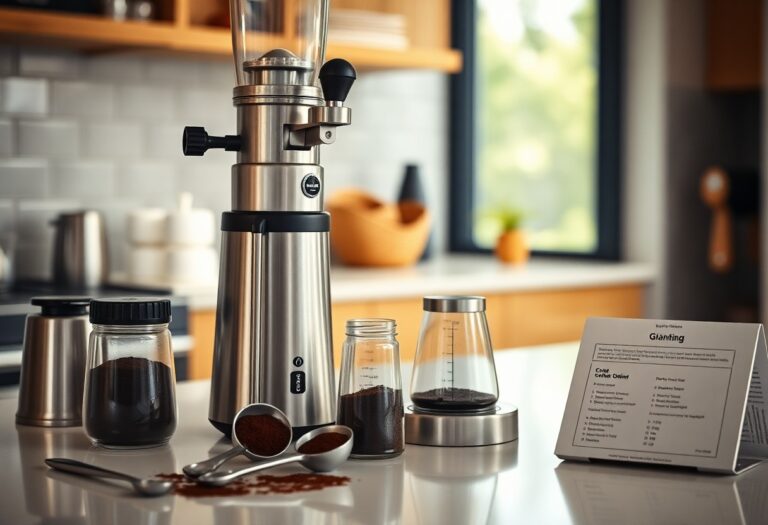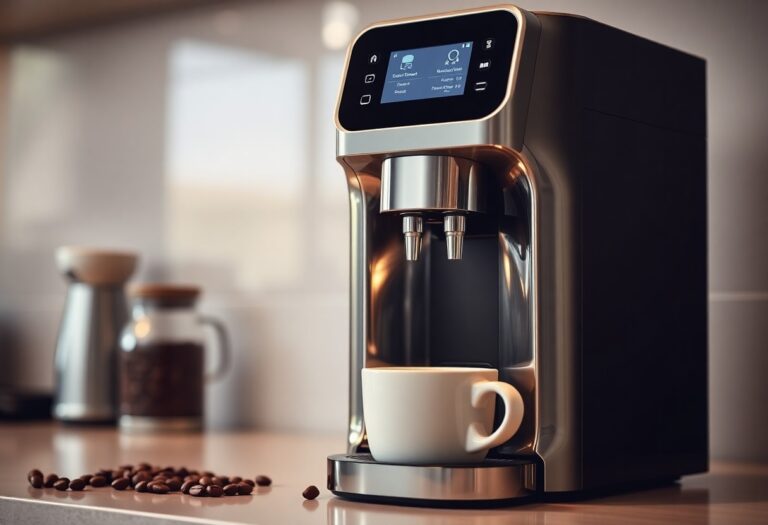How to Use a Bialetti Coffee Machine – Stovetop Brewing Guide
Many coffee enthusiasts are drawn to the rich flavor and robust aroma of the brew produced by a Bialetti coffee machine. This stovetop brewing method is not only simple but also allows you to manipulate the coffee’s strength to suit your taste. In this guide, you will learn the step-by-step process to brew the perfect cup while avoiding common pitfalls that can lead to burnt or weak coffee. With just a few tips and insights, you’ll be able to enjoy a delightful coffee experience every time.
Key Takeaways:
- Use freshly ground coffee for the best flavor and adjust the grind size to a medium-fine texture for optimal brewing.
- Fill the bottom chamber with water up to the safety valve to ensure proper pressure during brewing.
- Place the coffee grounds in the filter basket without pressing down, allowing for even extraction and preventing clogging.
- Heat the Bialetti on medium to low heat to control the brewing process and avoid burning the coffee.
- Once brewing is complete, remove from heat and allow it to cool for a moment before serving to enjoy the full aroma and flavor.
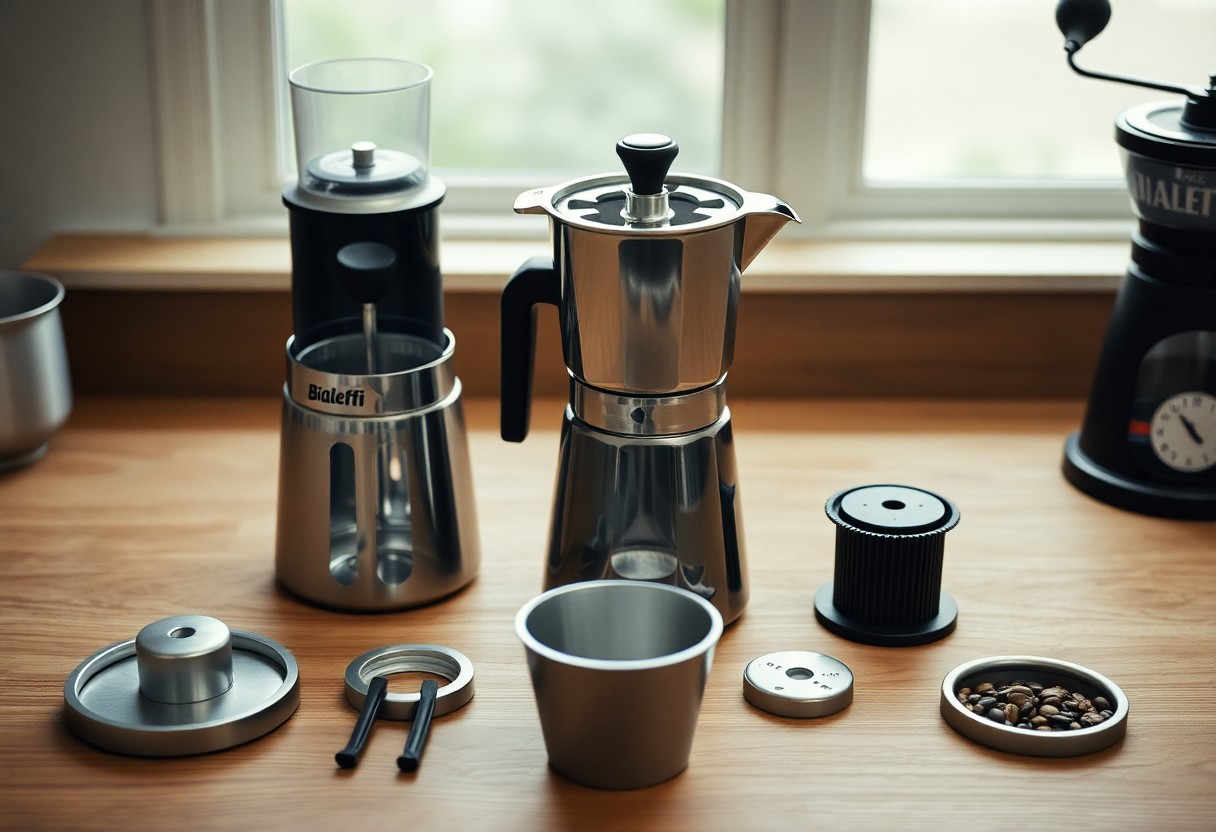
The Anatomy of Your Bialetti: Parts that Matter
Understanding the parts of your Bialetti coffee machine ensures a seamless brewing experience. The Bialetti consists of several components: the bottom chamber for water, the filter basket for coffee grounds, the top chamber for brewed coffee, and the pressure valve that regulates steam and pressure. Each part plays a vital role in delivering that rich, espresso-like flavor you crave. For an in-depth look, consult this Stovetop Espresso Brewing Tutorial.
Key Components Explained
The bottom chamber, where cold water is placed, is imperative for starting the brewing process. The filter basket holds your coffee grounds, allowing water vapor to rise through them and extract flavors. The top chamber collects the brewed coffee. A well-functioning pressure valve is necessary to manage steam pressure, preventing overflow and ensuring efficient extraction.
The Role of Water and Coffee Grounds
Water and coffee grounds are the fundamental elements that create your coffee. The quality of water directly influences the flavor profile, as impurities can alter taste. Freshly ground coffee, particularly with a medium-fine grind, ensures optimal extraction. When hot water rises through the coffee grounds, a balance between the two ingredients leads to that perfect cup. An insufficient grind leads to weak flavors, while overly fine grounds can clog the filter and over-extract, resulting in bitterness.
The unique interaction between water and coffee grounds determines the final brew strength and flavor. Water temperature should ideally range from 195°F to 205°F for optimal extraction; too hot, and you risk bitterness, while too cool can result in under-extraction, leaving you with a sour taste. It’s a delicate dance where the right ratio—usually about 1:15 of coffee to water—can help you achieve remarkable results. Experimenting with different water sources and grind sizes offers you a pathway to find that perfect cup tailored to your preferences.
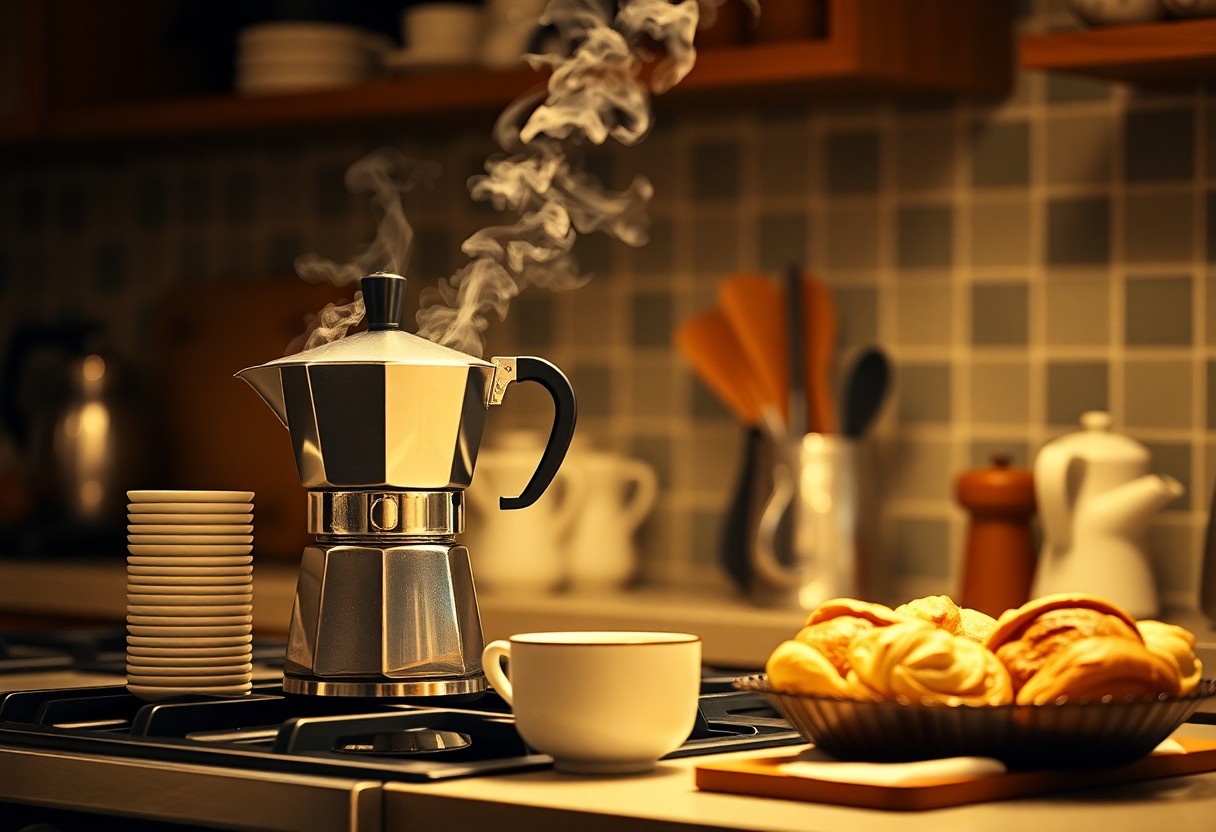
Mastering the Art of Stovetop Brewing
Stovetop brewing with a Bialetti is an art that balances precision and passion. Once you understand the mechanics of your machine and the science behind coffee, you can create a cup that perfectly suits your taste. Each step, from selecting your beans to measuring water, plays a pivotal role in elevating your coffee experience.
Selecting the Right Coffee Beans
Your coffee choice impacts flavor significantly; opt for freshly roasted, high-quality beans tailored to your palate. Beans from regions such as Colombia or Ethiopia offer unique flavor profiles, and medium roasts often work best for stovetop methods. Experimenting with different varieties enhances your brewing adventure and leads to discovering your perfect cup.
The Perfect Water-to-Coffee Ratio
A balanced water-to-coffee ratio is crucial for brewing rich, flavorful coffee. Typically, a good starting point is to use 1:15 for a robust cup—1 gram of coffee for every 15 grams of water. For example, 20 grams of coffee paired with 300 grams of water creates a satisfying brew. Adjust this ratio to match your personal strength preference; a slightly richer brew may appeal to you, while others may prefer a milder flavor. Experimentation allows you to find your ideal blend.
This ratio helps ensure that the water completely extracts the crucial oils and flavors from the coffee grounds. Targeting the right amount also prevents over-extraction, which can lead to bitterness or under-extraction that results in a flat taste. Factors like grind size and brewing time further influence the extraction process, so keep track of your adjustments for continued improvement. As you refine your technique, you’ll uncover the nuances that make each brew a unique experience.
Step-by-Step Brewing Process: From Start to Sip
| Step | Description |
| 1. Preparing Your Bialetti for Use | Start by disassembling your Bialetti coffee machine. Rinse all parts with hot water to remove any residue and ensure cleanliness. |
| 2. The Brewing Technique That Makes a Difference | Add medium-fine coffee grounds, ensuring they’re not packed too tightly. This allows water to flow initially through the coffee for optimum extraction. |
| 3. Common Mistakes to Avoid | Avoid overfilling the coffee basket or using incorrect grind sizes, which can lead to bitter flavors or under-extraction. |
Preparing Your Bialetti for Use
Disassemble the Bialetti by unscrewing the top and removing the coffee basket. Give each piece a good rinse with warm water, ensuring there is no soap residue. This prepares your machine for optimal brewing and prevents unwanted flavors from interfering with your coffee.
The Brewing Technique That Makes a Difference
Achieving the perfect cup of coffee requires a thoughtful brewing process. Begin by filling the lower chamber with water, ensuring it does not exceed the safety valve. Add your carefully measured coffee grounds into the funnel basket without packing them down. This method allows water to pass evenly, extracting a rich flavor profile.
For successful brewing, control your water temperature. Using water that’s too hot can scorch the coffee grounds, resulting in bitterness. Instead, aim for a temperature between 190°F to 205°F. Allow the pressure to build up naturally as the water heats, ensuring the coffee grounds get adequately saturated.
Common Mistakes to Avoid
One common mistake is using the wrong coffee grind size, either too coarse or too fine, which can lead to poor extraction outcomes. Overfilling the coffee basket is another misstep; it prevents water from flowing freely through the grounds, affecting taste. Additionally, underestimating the importance of cleanliness can introduce unwanted flavors into your coffee.
Neglecting maintenance can lead to a bitter brew. Keep your Bialetti clean, as residues can build up and affect future coffee batches. Proper measurements of water and coffee are crucial for flavor balance; thus, invest in a scale to achieve consistency with each brew. By avoiding these mistakes, you’ll enhance your overall coffee experience significantly.
Advanced Brewing Techniques: Elevating Your Caffeine Experience
Enhancing your brewing skills can transform your mornings. By incorporating advanced techniques, you can create a coffee experience that transcends the everyday. Here are some ways to refine your stovetop brewing process:
- Experiment with different types of coffee beans.
- Try various grind sizes.
- Modify your brew time for flavor nuances.
- Utilize filtered water for purer flavor.
- Warm your coffee pot before brewing to maintain temperature.
For more details on mastering your Bialetti, check out Using Bialetti Coffee Makers.
| Advanced Techniques | Description |
|---|---|
| Beans Selection | Explore different roast profiles for unique flavors. |
| Grind Size | Adjusting grind can significantly influence taste. |
| Brew Time | Control extraction by varying brewing duration. |
Experimenting with Grind Sizes
The grind size you choose can significantly alter the flavor profile of your coffee. A finer grind extracts more oils and flavors quickly, leading to a bolder brew, while a coarser grind may produce a milder, smoother cup. Take time to test different sizes to find your ideal balance, adjusting by small increments for optimal taste.
Adjusting Brew Time for Flavor Variations
Modifying your brew time opens up a world of flavor possibilities. A short brew time may yield a lighter, acidic cup, whereas an extended brew can lead to deeper, richer flavors. Finding the perfect brew time for your taste can involve trial and error—experimenting with increments of about 10 seconds can create varying profiles of sweetness and bitterness. Watch your temperature, too; boiling water can extract harsh flavors.
Focusing on brew time, aim for around 4-5 minutes for finely ground coffee. If you prefer a milder taste, reduce the time by 30 seconds. Eventually, you’ll discern the exact duration that brings out the best flavors in your chosen beans. Don’t hesitate to keep a journal of your results, as this can assist in future adjustments and consistently delicious brews.
Maintenance and Care: Ensuring Longevity of Your Bialetti
Regular maintenance and care are key to ensuring that your Bialetti coffee maker remains in excellent condition for years of perfect brews. By taking a few simple steps, you can preserve the integrity of the materials and the quality of your coffee, avoiding common issues like residue buildup and wear.
Cleaning Your Bialetti
After each use, you should clean your Bialetti thoroughly to prevent any lingering flavors or oils from affecting future brews. Disassemble the unit and wash each part with warm water, avoiding harsh detergents that may cause damage. Dry the components thoroughly before reassembling to ensure no moisture is trapped inside.
Tips for Storing and Preserving
Storing your Bialetti properly can enhance its lifespan and performance. Always keep it in a dry, cool place free from direct sunlight. Ensure that the unit is completely dry before storing, as moisture can lead to rust or mold growth. Avoid stacking heavy items on top of the Bialetti to prevent structural damage.
- Thorough cleaning after each use will prevent flavor transfer.
- Warm water is sufficient for washing components.
- Store in a cool, dry place to avoid rust and spoilage.
- Completely dry all parts before storage.
- Any improper care may shorten the lifespan of your espresso maker.
For effective storage, protect your Bialetti by placing it in a padded coffee or kitchen drawer, or using a dedicated shelf that reduces exposure to dust and moisture. Make sure no foreign objects are stored in close proximity that could scratch or damage its finish. Any care taken during storage ensures that every brew you make will be perfect.
- Use a padded drawer or shelf for storage to prevent damage.
- Avoid moisture exposure to keep the coffee maker in optimal condition.
- Protect the exterior with a cover if it’s stored for long periods.
- Any extra care will help maintain the beauty and functionality of your Bialetti.
Summing up
On the whole, using a Bialetti coffee machine is a straightforward process that allows you to enjoy rich, flavorful coffee right at home. By following the steps outlined in this guide, you can effectively assemble your machine, measure the right coffee and water, and achieve the perfect stovetop brew. Make sure to maintain your Bialetti for consistent results, and soon, you’ll master the art of Italian coffee-making, enhancing your daily routine with every cup you brew.
FAQ
Q: How do I assemble my Bialetti coffee machine before brewing?
A: To assemble your Bialetti coffee machine, start by unscrewing the two halves of the moka pot. The bottom half holds the water, while the upper half collects the brewed coffee. Place the funnel-shaped filter basket into the bottom half and fill it with freshly ground coffee, leveling it off without pressing it down. Next, pour water into the bottom chamber up to the safety valve, then align and screw the top half back onto the bottom. Ensure it’s secure before placing it on the stove.
Q: What type of coffee should I use for my Bialetti coffee machine?
A: The best coffee for a Bialetti coffee machine is finely ground coffee, similar in consistency to table salt. You can use dark roast or medium roast beans, depending on your preference. The freshness of the coffee is also important; use freshly ground beans for the best flavor.
Q: How long does it take to brew coffee with a Bialetti coffee machine?
A: Brewing coffee with a Bialetti moka pot typically takes about 4 to 5 minutes, depending on the heat of your stove and the amount of water used. You’ll know the coffee is ready when you hear a hissing sound and see coffee bubbling up into the upper chamber. Keep an eye on it to avoid over-extraction, which can lead to a bitter taste.
Q: How do I clean my Bialetti coffee machine after use?
A: To clean your Bialetti coffee machine, let it cool down first. Disassemble the pot and rinse each part with warm water without using soap, as it can leave residues that affect the taste of the coffee. Use a brush to clean the filter screen and check for any clogging. Allow all components to air dry completely before reassembling and storing. Regular cleaning ensures optimal flavor and longevity of the pot.
Q: Can I use a Bialetti coffee machine on an induction stove?
A: Yes, but make sure to use a Bialetti model specifically designed for induction stoves, as standard aluminum models won’t work on induction surfaces. Induction-compatible moka pots usually have a base made from stainless steel that enables them to heat effectively on induction cooktops. Check the product specifications to ensure compatibility before use.

